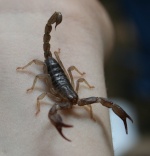Mr. Mordax
Administrator

Number of posts : 7743
Age : 38
Location : PNW
Registration date : 2008-02-06
 |  Subject: Babycurus spp. Subject: Babycurus spp.  3/5/2008, 4:43 am 3/5/2008, 4:43 am | |
| Males have bulbous chela when compared to the females (this difference is not noticeable until males are adult).  Female left, male right Females molt once more during their life than males, at which point they are slightly larger than the male (the difference in chela is still visible).  Female top, male bottom
Last edited by IHeartMantids on 3/5/2008, 4:48 am; edited 2 times in total (Reason for editing : Wrong IMG code) | |
|
rafiqos
Centruroides

Number of posts : 104
Age : 42
Location : Malaysia
Registration date : 2008-04-21
 |  Subject: Re: Babycurus spp. Subject: Re: Babycurus spp.  5/19/2009, 8:15 pm 5/19/2009, 8:15 pm | |
| A friend of mine believes that the pectines also offer IDing for sex. Males have longer bristles than females of the same size. He's had success breeding 2 broods of Babycurus jacksoni so far and I hold him very dear for sharing many precious tips with me.
Is this a valid method? | |
|
Mr. Mordax
Administrator

Number of posts : 7743
Age : 38
Location : PNW
Registration date : 2008-02-06
 |  Subject: Re: Babycurus spp. Subject: Re: Babycurus spp.  5/19/2009, 11:41 pm 5/19/2009, 11:41 pm | |
| You'd probably have to have a side-by-side comparison to use it -- if you're counting the teeth, I've heard that the counts overlap and aren't valid for sexing. | |
|
Sponsored content
 |  Subject: Re: Babycurus spp. Subject: Re: Babycurus spp.  | |
| |
|

